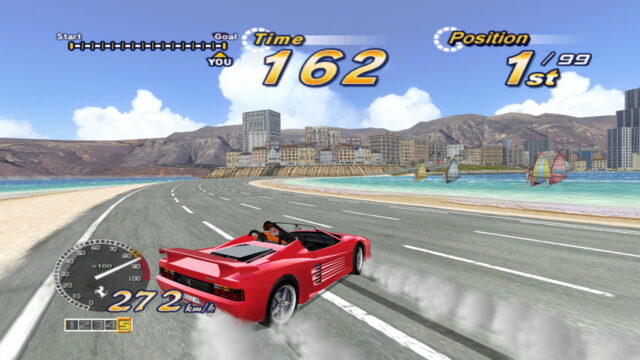
OutRun 2006: Coast 2 Coast
Written by: Rik
Date posted: December 9, 2018
- Genre: Racing
- Developed by: Sumo Digital
- Published by: SEGA
- Year released: 2006
- Our score: 7
The original OutRun was the smash hit arcade racer of the 1980s, although unless you were actually able to head down to the arcades with a fistful of coins on a regular basis, your main way of experiencing it (outside of an occasional glimpse of a machine on a car ferry) was likely to be through one of a number of seriously underwhelming home ports, which only served to heighten the almost mythical status of the arcade version. My own experience was with the Atari ST port, which looked promising enough in stills, but in motion it was a different story. (And yes, there was a DOS version, although that didn’t even look good in stills).
OutRun 2 came to arcades in 2003, although there had previously been other titles to bear the OutRun name, including 1989’s direct follow-up, Turbo OutRun, which replaced the Ferrari Testarossa with an F40; the lesser-known OutRunners in 1992; and the largely-forgotten Megadrive game OutRun 2019 in 1993. After some tinkering with the formula over the years, OutRun 2 was more of a modern reboot than sequel, and it soon made its way to home consoles in the form of an Xbox port in 2004, the home version this time suffering rather less in comparison to the original.
OutRun 2006: Coast 2 Coast packages up OutRun 2 with the additional courses and content from the special edition known as OutRun 2 SP and an all-new career mode (the Coast 2 Coast of the title), and was released on a wider variety of formats, with the PC joining the Xbox, PS2 and PSP in getting a version of its own. OR2006 (as it shall henceforth be known) therefore gives you the chance to experience OutRun 2 in almost every conceivable flavour combination, kind of like a best-of collection.
At the short-and-sharp end of the available single-player modes, we have OutRun, which uses the branching road mechanism to set difficulty as in the 80s original: beat the clock, and at the end of each stage choose the left lane for an easy follow-up and right for a harder one. At the end of 5 stages you reach the end, and a cheering crowd. (There’s also an option, which needs to be unlocked, to race through all 15 stages continuously). Heart Attack, meanwhile, is along similar lines but combines the need to race quickly with the additional challenge of satisfying the various whims of your girlfriend – keeping your speed up, drifting, driving through cones etc. And Time Attack dispenses with all distractions, including traffic, and allows you to focus on setting the best time across your chosen 5 stages.
To all that, OR2006 adds the Coast 2 Coast mode, an attempt to stretch the core OutRun and Heart Attack challenges across a more substantial time frame. Whatever your views on the purity of an arcade format, it’s not designed for sustained play, and if mainstream rivals of the era are boasting long-lasting career modes, it kind of means you need to do the same, particularly as Xbox OutRun 2 copped flak from some quarters for being perceived as somewhat insubstantial.
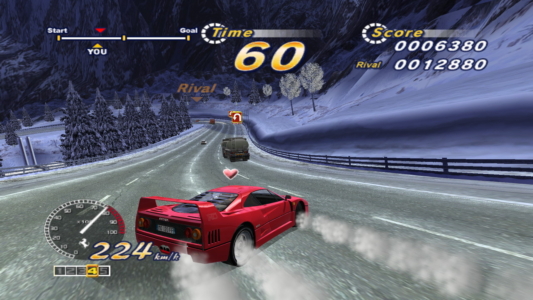
At one point in time the F40 seemed to feature in every racing game going. Now it’s kind of a novelty – I still have a soft spot for it though.
The basic premise of OutRun was that it was you, your Ferrari and the open road, and OR2006 does little to embellish that formula. On the other hand, you do now have a selection of Ferrari cars to choose from, beyond the iconic Testarossa, and instead of a low/high gearshift you have either a five or six speed box depending on your chosen model. But the core gameplay, based around avoiding traffic and keeping up speed at corners, remains. Mastery of two key mechanics is required: slipstreaming other vehicles by lurking behind them for a speed boost, and – most crucially – the drift, and chain linking of drifts, in order to navigate tight sequences of corners at the highest possible speed. The OutRun mode is all about racing, while Heart Attack adds an extra element of distraction – you need to fulfil tasks, yes, but you still need to be fast enough to beat the clock at the same time.
Most gamers, myself included, will by now have been trained to instinctively plump for the career mode at the earliest opportunity, given that they usually start with a fairly gentle introduction. Coast 2 Coast is no exception in this regard: in fact, the introduction is almost too gentle for too long, to the extent that you can blunder along without truly understanding what’s required to succeed or mastering those key mechanics for quite some time, only to reach a point where you can go no further. The basics are so simple, particularly if you choose automatic gears (as I always do, like a big coward), that you don’t quite understand what lies beneath. Like many an arcade title, it hides a hardcore gameplay aesthetic under simple controls and ludicrous cartoonish presentation.
The need to impress a female passenger, as required by the career mode’s spin on Heart Attack, is particularly difficult to know how to take: a sprinkling of snigger-worthy double entendres from your partner (“I love your technique!”) punctuates an almost constant sound of smooching noises while small cartoon hearts fly across the screen. (The smooching stops and hearts literally turn to tears should you veer onto the grass verge). All the snooty Edge magazine thinkpieces in the world won’t help when your wife or partner walks past to witness such a spectacle.
This is actually one of the trickier and more repetitive elements of Coast 2 Coast, however. There are 3 girls to impress, each representing a difficulty level, and to progress you must average a minimum rank of A across all challenges. (All challenges in Coast 2 Coast are evaluated with a ranking grade, from AAA to E, with grade A really being the minimum considered a ‘pass’, with the rest merely an indication of just how shit you’ve been). These challenges are dotted across a traditional 15-stage Outrun course, and must be unlocked by racing through 5 of them consecutively. Simply choosing a route through the course will unlock some challenges, while others require good performance throughout to become available. Challenges can then be repeated in isolation to improve your ranking. (I was very puzzled about how this worked for a while, but you basically need to get a rank of AA on every challenge while racing the course – not individual stages – to unlock everything).
Over on the purer racing side, there’s someone else you need to impress – Mr Flagman, the rotund race starter. Sadly this does not involve him climbing into the car with you and showering you with kisses, but in a repurposed OutRun mode, he is the one to evaluate your performance with a rank. Generally, you’re racing against rivals (so-called, but generally they’re more drones than opponents, nothing more than a barometer of your own speed and time) but there are other challenges, based on slipstreaming or drifting and a girlfriend makes an occasional appearance (“Don’t be last or you’ll upset the girl!” intones cheesy voice-over man). As previously mentioned, it arguably isn’t until midway through the intermediate races that it clicks, and you’ll have spent a few hours with the game by then.
Padding is, to some extent, the name of the game in the arcade racer’s career mode: the same content and races chopped up and repeated with minor changes. In a Need for Speed or a Juiced, the grey urban environments allow this to be disguised a little but the distinctiveness of OR2006‘s various stages means that it soon becomes very obvious that the career mode is just flinging these stages at you in various different orders and combinations with very little context or purpose.
Yes, yes, it’s an arcade racer. How much context do you need? Well, I must admit that when I first bought this game on release, I read rather too much into the name Coast 2 Coast, believing it would mean that that OutRun‘s continuous stages template had been remoulded and extended into a race across America. (To be fair, that’s also the impression given by the game’s cover art, which clearly shows signs for New York and San Francisco). But it’s not. It’s stages from OutRun 2 and SP of indeterminate origin, including the Eiffel Tower at one point.
I was clearly ignorant of OutRun 2 and its arcade stylings. And perhaps of the true nature of the original OutRun, to be honest. I always imagined OutRun as the first driving game, as opposed to racing (an argument made very persuasively here) but clearly there are different directions you can take with the concept of “driving a Ferrari across the country” and mine involves something closer to Test Drive 2 in terms of fulfilling Smokey and the Bandit or Cannonball Run style fantasies. Part of the problem is that OutRun 2 doesn’t feel much like driving a car, and there’s a certain irony in that for a game that makes so much of the official Ferrari license and also now can’t be sold because that licence expired. The vehicles all look great, and there’s a wide selection available, but they kind of perform and sound like high-powered hovercraft.
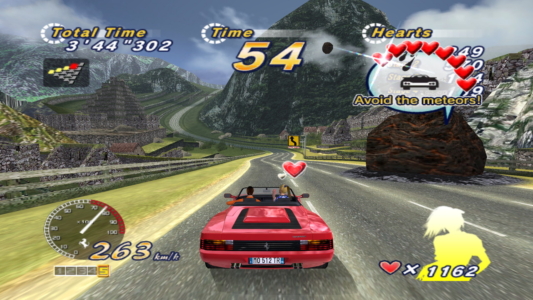
It might impress your passenger to do so but you should kind of have your own motivation for avoiding meteors falling from the sky.
To enjoy the game, I had to put all that aside. Just as you can make your peace with the fact that real tennis pros don’t practice with giant inflatable balls as opponents and have as the pinnacle of their career a match on carpet against an old man in tracksuit bottoms to enjoy Virtua Tennis, this is “Mr Sega lets you mess around in ridiculous-land with a Ferrari” – so deal with it. Otherwise you’ll really be freaked out when you reach the final girlfriend, Holly, who demands that you juggle mental arithmetic with the need to tell the difference between various items of fruit and wildlife while ensuring you retain sufficient control over your vehicle to drive through the appropriately marked cones. I suppose it says something (although I’m not sure exactly what) that the most demanding girl wants a man with brains, although I couldn’t help but imagine an escalation of this behaviour to the point where she’s only impressed if you can negotiate the road at high speed while completing a series of long division puzzles and simultaneously filming and narrating a series of nature documentaries.
Taken on its own terms, OR2006 is nevertheless a fast, good-looking and ultimately enjoyable arcade racer. The visuals are still impressive: it pings along at a good rate at 1080p and the scenery is truly impressive although – and apologies if this seems like the kind of thing that would be emblazoned across the back of a game box in 1988 but it’s true – you’ll barely have time to notice how good it looks because you’ll be moving so fast (!!) Obviously they’re a little dated now, but mid-90s teenagers of my generation would never have imagined arcade graphics ever getting better than this, never mind the fact that they would one day be replicated at home (and on a handheld).
Although Coast 2 Coast takes too long to reach its stride, the whole thing starts to click just as the intensity of the racing heats up. During the more intense challenges, as you reach the final stages of Flagman, taking on the narrower and more bendy courses like OR2’s Skyscrapers or SP’s Cape Way, the sweat, tension and white-knuckle grip of the joypad are all present and correct, with your correspondent reduced to flinching and gyrating on his chair at various points. In time, you also come to see the collisions and crashes – on the surface, unsatisfactory and unrealistic – as completely necessary and in keeping with the game: collisions are meant to be bad, so of course you should be punished for hitting an opponent by punting him or her further ahead of you. Crashes don’t happen often, with scrapes more regular, but when they do, as a result of a bad misjudgement, they’re almost fatal to your chances, which is as it should be.
We mentioned before how this was a kind of best-of/collector’s edition of OutRun 2, and even lapsed fans of the series will recall the iconic music of the original OutRun here, remixed and updated but with the originals and bonkers Euro remixes available to be purchased with XP earned through racing, known as OutRun Miles. I’d always assumed Splash Wave was the OutRun music but apparently this is not the case. It’s my favourite anyway. It’s also fun to unlock the various Ferraris – for fun more than necessity, as all cars in a particular class have identical stats, and I was pleased to find the F40 and Testarossa among the best to use, although the latter is true only upon unlocking the fastest (“OutRun”) class vehicles in the latter stages. And after completion of the Coast 2 Coast races it was fun putting my skills to the test on the arcade version of SP included here, experiencing the game as it was initially intended.
Having bought and abandoned OR2006 many years ago, mainly for not living up to the expectations of cross-country racing that I’d forced upon it, I was glad to rediscover it and enjoy it on its own merits. I’m afraid I can’t subscribe to the theory that it’s a lost classic, and at times I did pine for the grubby charms of a mid-00s Need for Speed game, which I’m sure will be heresy to hardcore OutRun fans. But it’s a good game and it’s a shame that it’s not being sold any more, particularly for such very silly and superficial licensing reasons.

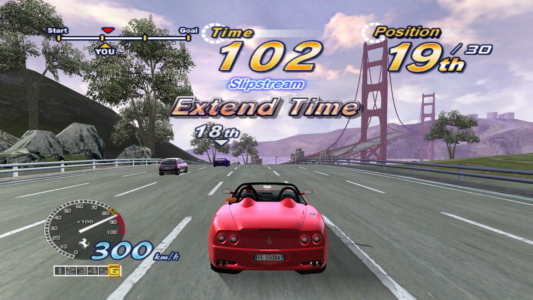

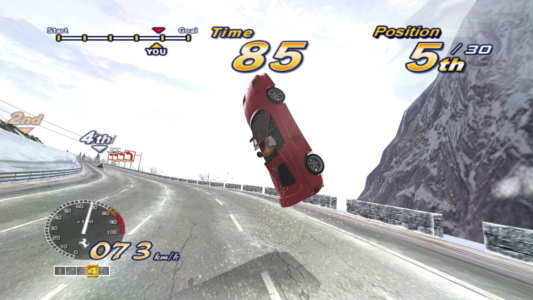
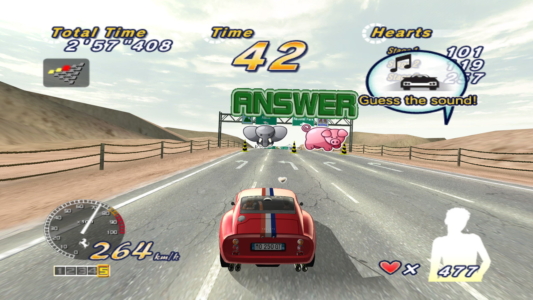

 Posts
Posts